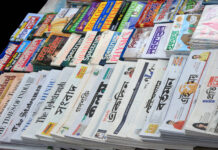The latest controversy surrounding an east London primary school banning young Muslim girls from wearing the hijab is yet another example of institutional Islamophobia, writes Naila Naidoo.
This week, St Stephens School in Newham, east London, has publicised its decision to ban eight-year-old Muslim girls from wearing the hijab. Newham is the most diverse borough in the country with a religious and ethnic demographic that should be embraced and cherished.
“Covered” women are prevalent in every aspect of life. In Newham, we see teachers, doctors, retail workers and council members all wearing the hijab whilst being productive members of British society. It is a normal and accepted sight that no one thinks twice about.
In a recent article in The Times, head teacher Neena Mall stated that “the school had made the changes to help pupils integrate into modern British society”. As a Muslim woman, I feel astounded that wearing the hijab could be perceived by an institution as a barrier to integration. Particularly considering what we experience every day as residents of the borough, which is covered Muslim women being integral to the fabric of life in our community, and being visible in every profession.
Consulting parents
The chair of governors, Arif Qawi, talks about a backlash from parents following this decision. This makes it clear that parental views and opinions weren’t taken into consideration. In fact these views are being dismissed based on his assertation “it just seems wrong…it is common sense.”
To Muslim women, however, it is “common sense” to take a look around us and realise that wearing the hijab does not prevent us from positively contributing to society. This appears to be just another way to dismiss and dehumanise Muslim women who cover by implying they are not happy, they are suppressed, they do not have agency, and actually actively taking that agency away from them by speaking on their behalf without consulting them.
Subscribe to our newsletter and stay updated on the latest news and updates from around the Muslim world!

The article in The Times also references to Amina Lone, the head of “The Social Action and Research Foundation”, who have campaigned against the “sexualisation” of young Muslim girls through wearing the hijab, and has been instrumental in influencing Ofsted policy to question primary aged children regarding their choice of clothing.
Although Amina Lone and her ilk claim to “address stigmatisation” and “collaborate with different communities”, there is no evidence of that in this case. In fact, the opposite effect can be seen and felt by Muslims.
We all want our daughters to grow up as happy, productive and confident members of society. Just like any other group of people. That includes being confident in their identity, their faith and their freedom of expression.
Selective “freedom” and “misogyny”
At a meeting in Redbridge with council members, a mother spoke about a child feeling ashamed and embarrassed to wear the hijab because of people’s perceptions, and how although she wanted to wear it, she was put off and didn’t have the confidence to. She said now it feels like we are going backward in time.
It now seems acceptable to ridicule and belittle the hijab as it is supported by the institutions, such as Ofsted, think-tanks like SARF, and now teachers in schools. Reducing the hijab and the complex reasons why Muslim women might wear it to an undefined definition of “sexualisation” is exactly that. Belittling, ridiculing and dehumanising the women who are wearing it, making it socially acceptable to attack them due to their choice of clothing.
 When singling out Muslim girls for questioning, that in itself is misogynistic, and another way for people to police female dress. Why are similar concerns not being made about Sikh boys who wear the turban?
When singling out Muslim girls for questioning, that in itself is misogynistic, and another way for people to police female dress. Why are similar concerns not being made about Sikh boys who wear the turban?
Is Ofsted planning to ask them if covering and growing their hair is “their choice” and their reasons for doing so? Is St Stephens School going to prevent Sikh boys from wearing turbans?
I can only assume the answer would be no, because of the belief that the reason why Sikh boys wear the turban is different. However, what evidence base have they used to determine that “sexualisation” is the reason why Muslim girls wear the hijab? What evidence is there to say that wearing the hijab has a bigger impact on integration than Sikh boys wearing the turban?
Perhaps more importantly, what is the psychological impact of decisions like these on Muslim girls? If you’re seeing a male counterpart of a different religion being free to express themselves and their faith without question, whereas as a Muslim girl you are questioned, and prevented from the same “freedom”, that is no doubt going to affect your psyche, your identity and your sense of belonging.
It is these very measures, that those claiming to speak on behalf of Muslim women advocate are being put into place to “protect them”, that result in the marginalisation and otherisation of Muslim youth. Children will know that they are being treated differently because of their gender and their faith, and that will have a long term impact on community cohesion.
The hijab
We have to take a step back and think who are these young girls wearing hijab? I have two daughters aged 9 and 10. One wears the hijab to school but not outside of school, one does not wear it at all. This is not enforced by me but what they have decided to do.
It is usual to see one sibling who wears the hijab and one who doesn’t, or a child who wears the hijab but their mother doesn’t, or a child who wears it one day but not the next. What are these children’s thought processes? Well, put yourself into the shoes of a seven-year-old girl, their thinking doesn’t go much past “I like it”, “I want to”, or “It looks nice”. How are Ofsted expecting children to explain something like this? How does a seven-year-old articulate “It is part of my identity that I want to try out” or any other religious sentiment?
Covered Muslim women should be at the centre of this discourse about this issue. Their voice needs to be heard. I encourage all of you out there to speak up and not let others speak for you or at you.
Fasting
As for the fasting “issue”, it is normal for even Islamic faith schools to have restrictions on younger children fasting. However, the way of approaching the situation could have been less confrontational and more considerate of the community needs.
Let’s be clear – no one makes eight-year-olds fast. Ramadan is a time of excitement and joy for Muslims, yes, including children. It is common for Muslim families to allow their young children to do “half fasts”. This means they wake up for breakfast with the family, are involved in the excitement of it and then “break their fast” at lunch time or when they feel hungry or thirsty.
A simple statement from the school saying we recommend that younger children who wish to try fasting do half fasts, may have gone down a lot better. However, it would have required engagement with the community of parents, and actually taking the time to listen to their needs and opinions to come up with a solution such as this. It is common sense that calling it “just wrong” that children are excited to emulate and participate in a fundamental pillar of their faith is, well, just wrong.
The Muslim community in Newham and its surrounding areas are genuinely concerned about where this line of policy is going, and the impact on parents to be able to raise children in the faith that they choose, and follow the religious practices that they choose.
They are also concerned about the singling out of Islam and Muslim women for scrutiny. In conjunction with the current climate of Islamophobia, this makes them feel under attack and contributes to further marginalisation and isolation that we are trying every day to overcome.
This toxic narrative and draconian approach must change. Community leaders, local authorities and academic institutions need to be part of a more positive change.
Naila Naidoo is the director of Newham Muslim Women’s Association, a grassroots community organisation working to empower families through education, advice and support. You can follow Naila on Twitter @NailaNaidoo.




















